AK-47
The AK-47, officially known as the Avtomat Kalashnikova (Russian: Автома́т Кала́шникова, tr. Avtomát Kaláshnikova, lit. 'Kalashnikov’s automatic device'; also known as the Kalashnikov and AK), is a gas-operated, 7.62×39mm assault rifle, developed in the Soviet Union by Mikhail Kalashnikov. It is the originating firearm of the Kalashnikov rifle (or "AK") family. 47 refers to the year it was finished.
| AK-47[N 1] | |
|---|---|
 AK-47 Type 2 with fixed bayonet. | |
| Type | Assault rifle |
| Place of origin | Soviet Union |
| Service history | |
| In service | 1949–1974 (Soviet Union) 1949–present (other countries) |
| Used by | See Users |
| Wars | See Conflicts |
| Production history | |
| Designer | Mikhail Kalashnikov |
| Designed | 1946–1948[1] |
| Manufacturer | Kalashnikov Concern and various others including Norinco |
| Produced | 1948–present[2][3] |
| No. built | ≈ 75 million AK-47s, 100 million Kalashnikov-family weapons.[4][5] |
| Variants | See Variants |
| Specifications | |
| Mass | Without magazine: 3.47 kg (7.7 lb) Magazine, empty: 0.43 kg (0.95 lb) (early issue)[6] 0.33 kg (0.73 lb) (steel)[7] 0.25 kg (0.55 lb) (plastic)[8] 0.17 kg (0.37 lb) (light alloy)[7] |
| Length | Fixed wooden stock: 880 mm (35 in)[8] 875 mm (34.4 in) folding stock extended 645 mm (25.4 in) stock folded[6] |
| Barrel length | Overall length: 415 mm (16.3 in)[8] Rifled bore length: 369 mm (14.5 in)[8] |
| Cartridge | 7.62×39mm |
| Action | Gas-operated, rotating bolt |
| Rate of fire | Cyclic rate of fire: 600 rds/min[8] Combat rate of fire: Semi-auto 40 rds/min[8] Bursts 100 rds/min[8] |
| Muzzle velocity | 715 m/s (2,350 ft/s)[8] |
| Effective firing range | 350 m (380 yd)[8] |
| Feed system | 30-round detachable box magazine[8] There are also 5- 10-, 20- and 40-round box and 75- and 100-round drum magazines available |
| Sights | 100–800 m adjustable iron sights Sight radius: 378 mm (14.9 in)[8] |
Design work on the AK-47 began in 1945. In 1946, the AK-47 was presented for official military trials, and in 1948, the fixed-stock version was introduced into active service with selected units of the Soviet Army. An early development of the design was the AKS (S—Skladnoy or "folding"), which was equipped with an underfolding metal shoulder stock. In early 1949, the AK-47 was officially accepted by the Soviet Armed Forces[9] and used by the majority of the member states of the Warsaw Pact.
Even after seven decades, the model and its variants remain the most popular and widely used rifles in the world because of its reliability under harsh conditions, low production costs compared to contemporary Western weapons, availability in virtually every geographic region, and ease of use. The AK-47 has been manufactured in many countries and has seen service with armed forces as well as irregular forces and insurgencies worldwide, and was the basis for developing many other types of individual, crew-served and specialised firearms. As of 2004, "Of the estimated 500 million firearms worldwide, approximately 100 million belong to the Kalashnikov family, three-quarters of which are AK-47s".[4]
History
Origins
During World War II, the Sturmgewehr 44 rifle used by German forces made a deep impression on their Soviet counterparts.[10][11] The select-fire rifle was chambered for a new intermediate cartridge, the 7.92×33mm Kurz, and combined the firepower of a submachine gun with the range and accuracy of a rifle.[12][13] On 15 July 1943, an earlier model of the Sturmgewehr was demonstrated before the People's Commissariat of Arms of the USSR.[14] The Soviets were impressed with the weapon and immediately set about developing an intermediate caliber fully automatic rifle of their own,[10][11] to replace the PPSh-41 submachine guns and outdated Mosin–Nagant bolt-action rifles that armed most of the Soviet Army.[15]
The Soviets soon developed the 7.62×39mm M43 cartridge,[14] the semi-automatic SKS carbine and the RPD light machine gun.[16] Shortly after World War II, the Soviets developed the AK-47 rifle, which would quickly replace the SKS in Soviet service.[17][18] Introduced in 1959, the AKM is a lighter stamped steel version and the most ubiquitous variant of the entire AK series of firearms. In the 1960s, the Soviets introduced the RPK light machine gun, an AK type weapon with a stronger receiver, a longer heavy barrel, and a bipod, that would eventually replace the RPD light machine gun.[16]
Concept
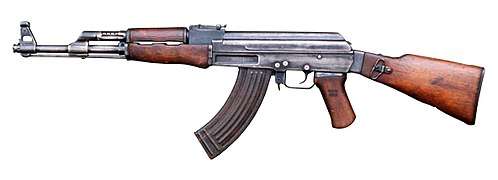
Mikhail Kalashnikov began his career as a weapon designer in 1941, while recuperating from a shoulder wound which he received during the Battle of Bryansk.[5][19] Kalashnikov himself stated..."I was in the hospital, and a soldier in the bed beside me asked: 'Why do our soldiers have only one rifle for two or three of our men, when the Germans have automatics?' So I designed one. I was a soldier, and I created a machine gun for a soldier. It was called an Avtomat Kalashnikova, the automatic weapon of Kalashnikov—AK—and it carried the year of its first manufacture, 1947."[20]
The AK-47 is best described as a hybrid of previous rifle technology innovations. "Kalashnikov decided to design an automatic rifle combining the best features of the American M1 and the German StG 44."[21] Kalashnikov's team had access to these weapons and had no need to "reinvent the wheel". Kalashnikov himself observed: "A lot of Russian Army soldiers ask me how one can become a constructor, and how new weaponry is designed. These are very difficult questions. Each designer seems to have his own paths, his own successes and failures. But one thing is clear: before attempting to create something new, it is vital to have a good appreciation of everything that already exists in this field. I myself have had many experiences confirming this to be so."[19]
There are claims about Kalashnikov copying other designs, like Bulkin's TKB-415[22] or Simonov's AVS-31.[23]
Early designs
Kalashnikov started work on a submachine gun design in 1942[24] and with a light machine gun in 1943.[25][26] "Early in 1944, Kalashnikov was given some 7.62×39mm M43 cartridges and informed that there were several designers working on weapons for this new Soviet small-arms cartridge. It was suggested to him that this new weapon might well lead to greater things, and he undertook work on the new rifle."[27] In 1944, he entered a design competition with this new 7.62×39mm, semi-automatic, gas-operated, long stroke piston, carbine, strongly influenced by the American M1 Garand.[28] "The rifle that Kalashnikov designed was in the same class as the familiar SKS-45 Simonov with fixed magazine and gas tube above the barrel."[27] However, this new Kalashnikov design lost out to a Simonov design.[29]
In 1946, a new design competition was initiated to develop a new rifle.[30] Kalashnikov submitted an entry. It was gas-operated rifle with a short-stroke gas piston above the barrel, a breech-block mechanism similar to his 1944 carbine, and a curved 30-round magazine.[31] Kalashnikov's rifles AK-1 (with a milled receiver) and AK-2 (with a stamped receiver) proved to be reliable weapons and were accepted to a second round of competition along with other designs.
These prototypes (also known as the AK-46) had a rotary bolt, a two-part receiver with separate trigger unit housing, dual controls (separate safety and fire selector switches) and a non-reciprocating charging handle located on the left side of the weapon.[31][32] This design had many similarities to the StG 44.[33] In late 1946, as the rifles were being tested, one of Kalashnikov's assistants, Aleksandr Zaitsev, suggested a major redesign to improve reliability. At first, Kalashnikov was reluctant, given that their rifle had already fared better than its competitors. Eventually, however, Zaitsev managed to persuade Kalashnikov.
In November 1947, the new prototypes (AK-47s) were completed. It used a long-stroke gas piston above the barrel. The upper and lower receivers were combined into a single receiver. The selector and safety were combined into a single control-lever/dust-cover on the right side of the rifle. And, the bolt-handle was simply attached to the bolt-carrier. This simplified the design and production of the rifle. The first army trial series began in early 1948.[34] The new rifle proved to be reliable under a wide range of conditions with convenient handling characteristics. In 1949, it was adopted by the Soviet Army as "7.62 mm Kalashnikov rifle (AK)".[9]
Further development
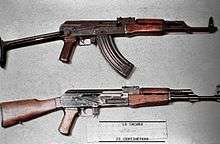
There were many difficulties during the initial phase of production. The first production models had stamped sheet metal receivers with a milled trunnion and butt stock insert, and a stamped body. Difficulties were encountered in welding the guide and ejector rails, causing high rejection rates.[35] Instead of halting production, a heavy[N 2] machined receiver was substituted for the sheet metal receiver. Even though production of these milled rifles started in 1951, they were officially referred to as AK-49, based on the date their development started, but they are much widely known in the collectors' and current commercial market as "Type 2 AK-47".[36][37] This was a more costly process, but the use of machined receivers accelerated production as tooling and labor for the earlier Mosin–Nagant rifle's machined receiver were easily adapted.[38] Partly because of these problems, the Soviets were not able to distribute large numbers of the new rifle to soldiers until 1956. During this time, production of the interim SKS rifle continued.[35]
Once the manufacturing difficulties of non-milled receivers had been overcome, a redesigned version designated the AKM (M for "modernized" or "upgraded"; in Russian: Автомат Калашникова Модернизированный [Avtomat Kalashnikova Modernizirovanniy]) was introduced in 1959.[36] This new model used a stamped sheet metal receiver and featured a slanted muzzle brake on the end of the barrel to compensate for muzzle rise under recoil. In addition, a hammer retarder was added to prevent the weapon from firing out of battery (without the bolt being fully closed), during rapid or fully automatic fire.[35] This is also sometimes referred to as a "cyclic rate reducer", or simply "rate reducer", as it also has the effect of reducing the number of rounds fired per minute during fully automatic fire. It was also roughly one-third lighter than the previous model.[36]
| Receiver type | Description[38] |
|---|---|
| Type 1A/B | The original stamped receiver for the AK-47 first produced in 1948[2] adopted in 1949. The 1B was modified for an underfolding stock with a large hole present on each side to accommodate the hardware for the underfolding stock. |
| Type 2A/B | The first milled receiver made from steel forging. It went into production in 1951 and production ended in 1957. The Type 2A has a distinctive socketed metal "boot" connecting the butt stock to the receiver and the milled lightening cut on the sides runs parallel to the barrel. |
| Type 3A/B | "Final" version of the AK milled receiver made from steel bar stock. It went into production in 1955. The most ubiquitous example of the milled-receiver AK. The milled lightening cut on the sides is slanted to the barrel axis. |
| Type 4A/B | AKM receiver stamped from a smooth 1.0 mm (0.04 in) sheet of steel supported extensively by pins and rivets. It went into production in 1959. Overall, the most-used design in the construction of the AK-series rifles. |
Both licensed and unlicensed production of the Kalashnikov weapons abroad were almost exclusively of the AKM variant, partially due to the much easier production of the stamped receiver. This model is the most commonly encountered, having been produced in much greater quantities. All rifles based on the Kalashnikov design are frequently referred to as AK-47s in the West, although this is only correct when applied to rifles based on the original three receiver types.[39] In most former Eastern Bloc countries, the weapon is known simply as the "Kalashnikov" or "AK". The differences between the milled and stamped receivers includes the use of rivets rather than welds on the stamped receiver, as well as the placement of a small dimple above the magazine well for stabilization of the magazine.
Replacement
In 1974, the Soviets began replacing their AK-47 and AKM rifles with a newer design, the AK-74, which uses 5.45×39mm ammunition. This new rifle and cartridge had only started to be manufactured in Eastern European nations when the Soviet Union collapsed, drastically slowing production of the AK-74 and other weapons of the former Soviet bloc.
Design
The AK-47 was designed to be a simple, reliable fully automatic rifle that could be manufactured quickly and cheaply, using mass production methods that were state of the art in the Soviet Union during the late 1940s.[40] The AK-47 uses a long stroke gas system that is generally associated with great reliability in adverse conditions.[28][41][42] The large gas piston, generous clearances between moving parts, and tapered cartridge case design allow the gun to endure large amounts of foreign matter and fouling without failing to cycle.
Cartridge

The AK fires the 7.62×39mm cartridge with a muzzle velocity of 715 m/s (2,350 ft/s).[8] The cartridge weight is 16.3 g (0.6 oz), the projectile weight is 7.9 g (122 gr).[43] The original Soviet M43 bullets are 123 grain boat-tail bullets with a copper-plated steel jacket, a large steel core, and some lead between the core and the jacket. The AK has excellent penetration when shooting through heavy foliage, walls or a common vehicle's metal body and into an opponent attempting to use these things as cover. The 7.62×39mm M43 projectile does not generally fragment when striking an opponent and has an unusual tendency to remain intact even after making contact with bone. The 7.62×39mm round produces significant wounding in cases where the bullet tumbles (yaws) in tissue,[44] but produces relatively minor wounds in cases where the bullet exits before beginning to yaw.[45][46][47] In the absence of yaw, the M43 round can pencil through tissue with relatively little injury.[45][48]
Most, if not all, of the 7.62×39mm ammunition found today is of the upgraded M67 variety. This variety deleted the steel insert, shifting the center of gravity rearward, and allowing the projectile to destabilize (or yaw) at about 3.3 in (8.4 cm), nearly 6.7 in (17 cm) earlier in tissue than the M43 round.[49] This change also reduces penetration in ballistic gelatin to ~25 in (64 cm) for the newer M67 round versus ~29 in (74 cm) for the older M43 round.[49][50] However, the wounding potential of M67 is mostly limited to the small permanent wound channel the bullet itself makes, especially when the bullet yaws.[49]
Operating mechanism

To fire, the operator inserts a loaded magazine, pulls back and releases the charging handle, and then pulls the trigger. In semi-automatic, the firearm fires only once, requiring the trigger to be released and depressed again for the next shot. In fully automatic, the rifle continues to fire automatically cycling fresh rounds into the chamber until the magazine is exhausted or pressure is released from the trigger. After ignition of the cartridge primer and propellant, rapidly expanding propellant gases are diverted into the gas cylinder above the barrel through a vent near the muzzle. The build-up of gases inside the gas cylinder drives the long-stroke piston and bolt carrier rearward and a cam guide machined into the underside of the bolt carrier, along with an ejector spur on the bolt carrier rail guide, rotates the bolt approximately 35° and unlocks it from the barrel extension via a camming pin on the bolt. The moving assembly has about 5.5 mm (0.2 in) of free travel, which creates a delay between the initial recoil impulse of the piston and the bolt unlocking sequence, allowing gas pressures to drop to a safe level before the seal between the chamber and the bolt is broken. The AK-47 does not have a gas valve; excess gases are ventilated through a series of radial ports in the gas cylinder. The Kalashnikov operating system offers no primary extraction upon bolt rotation, but uses an extractor claw to eject the spent cartridge case.[51]
Barrel
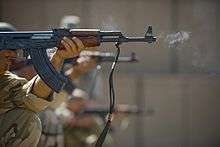
The rifle received a barrel with a chrome-lined bore and four right-hand grooves at a 240 mm (1 in 9.45 in) or 31.5 calibers rifling twist rate. The gas block contains a gas channel that is installed at a slanted angle in relation to the bore axis. The muzzle is threaded for the installation of various muzzle devices such as a muzzle brake or a blank-firing adaptor.
Gas block
The gas block of the AK-47 features a cleaning rod capture or sling loop. Gas relief ports that alleviate gas pressure are placed horizontally in a row on the gas cylinder.
Fire selector
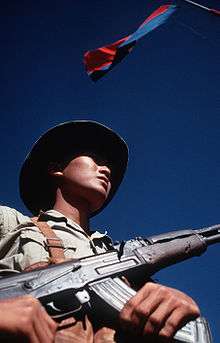
The fire selector is a large lever located on the right side of the rifle, it acts as a dust-cover and prevents the charging handle from being pulled fully to the rear when it is on safe.[52] It is operated by the shooter's right fore-fingers and has 3 settings: safe (up), full-auto (center), and semi-auto (down).[52] The reason for this is that under stress a soldier will push the selector lever down with considerable force bypassing the full-auto stage and setting the rifle to semi-auto.[52] To set the AK-47 to full-auto requires the deliberate action of centering the selector lever.[52] To operate the fire selector lever, right handed shooters have to briefly remove their right hand from the pistol grip, which is ergonomically sub-optimal. Some AK-type rifles also have a more traditional selector lever on the left side of the receiver just above the pistol grip.[52] This lever is operated by the shooter's right thumb and has three settings: safe (forward), full-auto (center), and semi-auto (backward).[52]
Sights

The AK-47 uses a notched rear tangent iron sight calibrated in 100 m (109 yd) increments from 100 to 800 m (109 to 875 yd).[53] The front sight is a post adjustable for elevation in the field. Horizontal adjustment requires a special drift tool and is done by the armory before issue or if the need arises by an armorer after issue. The sight line elements are approximately 48.5 mm (1.9 in) over the bore axis. The "point-blank range" battle zero setting "П" standing for постоянная (constant) on the 7.62×39mm AK-47 rear tangent sight element corresponds to a 300 m (328 yd) zero.[53][54] These settings mirror the Mosin–Nagant and SKS rifles, which the AK-47 replaced. For the AK-47 combined with service cartridges, the 300 m battle zero setting limits the apparent "bullet rise" within approximately −5 to +31 cm (−2.0 to 12.2 in) relative to the line of sight. Soldiers are instructed to fire at any target within this range by simply placing the sights on the center of mass (the belt buckle, according to Russian and former Soviet doctrine) of the enemy target. Any errors in range estimation are tactically irrelevant, as a well-aimed shot will hit the torso of the enemy soldier. Some AK-type rifles have a front sight with a flip-up luminous dot that is calibrated at 50 m (55 yd), for improved night fighting.[53]
Furniture
The AK-47 was originally equipped with a buttstock, handguard and an upper heat guard made from solid wood. With the introduction of the Type 3 receiver the buttstock, lower handguard and upper heatguard were manufactured from birch plywood laminates.[38] Such engineered woods are stronger and resist warping better than the conventional one-piece patterns, do not require lengthy maturing, and are cheaper. The wooden furniture was finished with the Russian amber shellac finishing process. AKS and AKMS models featured a downward-folding metal butt-stock similar to that of the German MP40 submachine-gun, for use in the restricted space in the BMP infantry combat vehicle, as well as by paratroops. All 100 series AKs use plastic furniture with side-folding stocks.
Magazines
The standard magazine capacity is 30 rounds. There are also 10, 20, and 40-round box magazines, as well as 75-round drum magazines.
The AK-47's standard 30-round magazines have a pronounced curve that allows them to smoothly feed ammunition into the chamber. Their heavy steel construction combined with "feed-lips" (the surfaces at the top of the magazine that control the angle at which the cartridge enters the chamber) machined from a single steel billet makes them highly resistant to damage. These magazines are so strong that "Soldiers have been known to use their mags as hammers, and even bottle openers".[55][56] This contributes to the AK-47 magazine being more reliable, but makes it heavier than U.S. and NATO magazines.
The early slab-sided steel AK-47 30-round detachable box magazines had 1 mm (0.039 in) sheet-metal bodies and weighed 0.43 kg (0.95 lb) empty.[42] The later steel AKM 30-round magazines had lighter sheet-metal bodies with prominent reinforcing ribs weighing 0.33 kg (0.73 lb) empty.[42][57] To further reduce weight, a lightweight magazine with an aluminum body with a prominent reinforcing waffle rib pattern weighing 0.19 kg (0.42 lb) empty was developed for the AKM that proved to be too fragile and the small issued amount of these magazines was quickly withdrawn from service. As a replacement steel-reinforced 30-round plastic 7.62×39mm box magazines were introduced. These rust-colored magazines weigh 0.24 kg (0.53 lb) empty and are often mistakenly identified as being made of Bakelite (a phenolic resin), but were actually fabricated from two-parts of AG-S4 molding compound (a glass-reinforced phenol-formaldehyde binder impregnated composite), assembled using an epoxy resin adhesive.[58][59][60] Noted for their durability, these magazines did however compromise the rifle's camouflage and lacked the small horizontal reinforcing ribs running down both sides of the magazine body near the front that were added on all later plastic magazine generations.[60] A second generation steel-reinforced dark-brown (color shades vary from maroon to plum to near black) 30-round 7.62×39mm magazine was introduced in the early 1980s, fabricated from ABS plastic. The third generation steel-reinforced 30-round 7.62×39mm magazine is similar to the second generation, but is darker colored and has a matte nonreflective surface finish. The current issue steel-reinforced matte true black nonreflective surface finished 7.62×39mm 30-round magazines, fabricated from ABS plastic weigh 0.25 kg (0.55 lb) empty.[8]
Early steel AK-47 magazines are 9.75 in (248 mm) long; the later ribbed steel AKM and newer plastic 7.62×39mm magazines are about 1 in (25 mm) shorter.[61][62]
The transition from steel to mainly plastic magazines yields a significant weight reduction and allows a soldier to carry more ammunition for the same weight.
| Rifle | Cartridge | Cartridge weight | Weight of empty magazine | Weight of loaded magazine | Max. 10.12 kg (22.3 lb) ammunition load* |
|---|---|---|---|---|---|
| AK-47 (1949) | 7.62×39mm | 16.3 g (252 gr) | slab-sided steel 430 g (0.95 lb) |
30-rounds 916 g (2.019 lb)[42] |
11 magazines for 330 rounds 10.08 kg (22.2 lb) |
| AKM (1959) | 7.62×39mm | 16.3 g (252 gr) | ribbed stamped-steel 330 g (0.73 lb) |
30-rounds 819 g (1.806 lb)[42][57] |
12 magazines for 360 rounds 9.83 kg (21.7 lb) |
| AK-103 (1994) | 7.62×39mm | 16.3 g (252 gr) | steel-reinforced plastic 250 g (0.55 lb) |
30-rounds 739 g (1.629 lb)[42][57] |
13 magazines for 390 rounds 9.61 kg (21.2 lb) |
All 7.62×39mm AK magazines are backwards compatible with older AK variants.
10.12 kg (22.3 lb) is the maximum amount of ammo that the average soldier can comfortably carry. It also allows for best comparison of the three most common 7.62×39mm AK magazines.
Most Yugoslavian and some East German AK magazines were made with cartridge followers that hold the bolt open when empty; however, most AK magazine followers allow the bolt to close when the magazine is empty.
Accessories

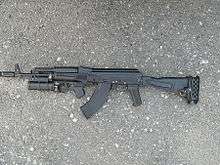
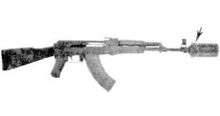
Accessories supplied with the rifle include a 387 mm (15.2 in) long 6H3 bayonet featuring a 200 mm (7.9 in) long spear point blade. The AK-47 bayonet is installed by slipping the 17.7 mm (0.70 in) diameter muzzle ring around the muzzle and latching the handle down on the bayonet lug under the front sight base.[63]
All current model AKM rifles can mount under-barrel 40 mm grenade launchers such as the GP-25 and its variants, which can fire up to 20 rounds per minute and have an effective range of up to 400 metres.[64] The main grenade is the VOG-25 (VOG-25M) fragmentation grenade which has a 6 m (9 m) (20 ft (30 ft)) lethality radius. The VOG-25P/VOG-25PM ("jumping") variant explodes 0.5–1 metre (1.6–3.3 ft) above the ground.[65]
The AK-47 can also mount a (rarely used) cup-type grenade launcher, the Kalashnikov grenade launcher that fires standard RGD-5 Soviet hand-grenades. The maximum effective range is approximately 150 meters.[66] This launcher can also be used to launch tear-gas and riot control grenades.
All current AKs (100 series) and some older models, have side rails for mounting a variety of scopes and sighting devices, such as the PSO-1 Optical Sniper Sight.[67] The side rails allow for the removal and remounting of optical accessories without interfering with the zeroing of the optic. However, the 100 series side folding stocks cannot be folded with the optics mounted.
Characteristics
Service life
The AK-47 and its variants have been and are made in dozens of countries, with "quality ranging from finely engineered weapons to pieces of questionable workmanship."[68] As a result, the AK-47 has a service/system life of approximately 6,000,[69] to 10,000,[70] to 15,000[71] rounds. The AK-47 was designed to be a cheap, simple, easy to manufacture rifle,[72] perfectly matching Soviet military doctrine that treats equipment and weapons as disposable items.[73] As units are often deployed without adequate logistical support and dependent on "battlefield cannibalization" for resupply, it is actually more cost-effective to replace rather than repair weapons.[73]
The AK-47 has small parts and springs that need to be replaced every few thousand rounds. However, "Every time it is disassembled beyond the field stripping stage, it will take some time for some parts to regain their fit, some parts may tend to shake loose and fall out when firing the weapon. Some parts of the AK-47 line are riveted together. Repairing these can be quite a hassle, since the end of the rivet has to be ground off and a new one set after the part is replaced."[53]
Variants
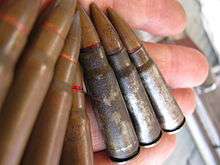
- Early variants (7.62×39mm)
- Issue of 1948/49: Type 1: The very earliest models, stamped sheet metal receiver, are now very rare.
- Issue of 1951: Type 2: Has a milled receiver. Barrel and chamber are chrome plated to resist corrosion.
- Issue of 1954/55: Type 3: Lightened, milled receiver variant. Rifle weight is 3.47 kg (7.7 lb).[6]
- AKS (AKS-47): Type 1, 2, or 3 receiver: Featured a downward-folding metal stock similar to that of the MP 40 produced in Nazi Germany, for use in the restricted space in the BMP infantry combat vehicle, as well as by paratroops.
- AKN (AKSN): Night scope rail.[74]
- Modernized (7.62×39mm)
- AKM: A simplified, lighter version of the AK-47; Type 4 receiver is made from stamped and riveted sheet metal. A slanted muzzle device was added to counter climb in automatic fire. Rifle weight is 3.1 kg (6.8 lb)[8] due to the lighter receiver. This is the most ubiquitous variant of the AK-47.
- RPK: Hand-held machine gun version with longer barrel and bipod. The variants—RPKS, RPKN (RPKSN), RPKL (RPKSL)—mirror AKM variants. The "S" variants have a side-folding wooden stock.
For the further developed AK models, see Kalashnikov rifles.
Production
Manufacturing countries of AK-47 and its variants in alphabetical order.
| Country | Military variant(s) |
|---|---|
| Albania [76] | Automatiku Shqiptar 1978 model 56 (ASH-78 Tip-1) made at Poliçan Arsenal (copy of Type 56 based on AKM rifle); model 56 Tip-2, copy of RPK; model 56 Tip-3 hybrid for multi-purpose roles with secondary rifle and grenade launcher capability; 1982 model (ASH-82) copy of AKMS. Several other versions of the AKMS have been produced mainly with short barrels similar to Soviet AKS-74U for special forces, tank & armoured crew and for helicopter pilots and police. There have also been modified ASh-82 (AKMS) with SOPMOD accessories, mainly for Albania's special forces RENEA & exports.[76] |
| Armenia | K-3 (bullpup, 5.45×39mm) |
| Azerbaijan [77] | Khazri (AK-74M)[77] |
| Bangladesh | Chinese Type 56 |
| Bulgaria | AKK/AKKS (Type 3 AK-47/w. side-folding buttstock); AKKMS (AKMS), AKKN-47 (fittings for NPSU night sights); AK-47M1 (Type 3 with black polymer furniture); AK-47MA1/AR-M1 (same as -M1, but in 5.56mm NATO); AKS-47M1 (AKMS in 5.56×45mm NATO); AKS-47S (AK-47M1, short version, with East German folding stock, laser aiming device); AKS-47UF (short version of -M1, Russian folding stock), AR-SF (same as −47UF, but 5.56mm NATO); AKS-93SM6 (similar to −47M1, cannot use grenade launcher); and RKKS (RPK), AKT-47 (.22 rimfire training rifle) |
| Cambodia | Chinese Type 56, Soviet AK-47, and AKM |
| China | Type 56 |
| Colombia | Galil ACE |
| Croatia | APS-95 |
| Cuba [78] | AKM [78] |
| East Germany [79] | MPi-K/MPi-KS (AK-47/AKS); MPi-KM (AKM; wooden and plastic stock), MPi-KMS-72 (side-folding stock), MPi-KMS-K (carbine); MPi-AK-74N (AK-74), MPi-AKS-74N (side-folding stock), MPi-AKS-74NK (carbine); KK-MPi Mod.69 (.22 LR select-fire trainer) [79] |
| Egypt | AK-47, Misr rifle (AKMS), Maadi ARM (AKM) |
| Ethiopia [80] | AK-47, AK-103 (manufactured locally at the State-run Gafat Armament Engineering Complex as the Et-97/1) [80] |
| Finland | Rk 62, Valmet M76 (other names Rk 62 76, M62/76), Valmet M78 (light machine gun), Rk 95 Tp |
| Hungary [81] | AK-55 (domestic manufacture of the 2nd Model AK-47); AKM-63 (also known as AMD-63 in the US; modernized AK-55), AMD-65M (modernized AKM-63, shorter barrel and side-folding stock), AMP-69 (rifle grenade launcher); AK-63F/D (other name AMM/AMMSz), AK-63MF (modernized); NGM-81 (5.56×45mm NATO; fixed and under-folding stock) [81] |
| India [82] | INSAS (fixed and side-folding stock), KALANTAK (carbine), INSAS light machine gun (fixed and side-folding stock), a local unlicensed version with carbon fibre furniture designated as AK-7;[82] and Trichy Rifle 7.62 mm manufactured by Ordnance Factory Tiruchirappalli of Ordnance Factories Board[83] |
| Iran | KLS/KLF (AK-47/AKS), KLT (AKMS) |
| Iraq | Tabuk Sniper Rifle, Tabuk Rifle (with fixed or underfolding stock, outright clones of Yugoslavian M70 rifles series), Tabuk Short Rifle (carbine) |
| Israel | IMI Galil: AR (/battle rifle), ARM (rifle/light machine gun), SAR (carbine), MAR (compact carbine), Sniper (sniper rifle), SR-99 (sniper rifle); and Galil ACE |
| Italy [84] | Bernardelli VB-STD/VB-SR (Galil AR/SAR) [84] |
| Nigeria [85] | Produced by the Defence Industries Corporation of Nigeria as OBJ-006[86][85] |
| North Korea | Type 58A/B (Type 3 AK-47/w. stamped steel folding stock), Type 68A/B (AKM/AKMS), Type 88A/B-2 (AK-74/AKS-74/w. top folding stock)[87][88] |
| Pakistan [89] | Reverse engineered by hand and machine in Pakistan's highland areas (see Khyber Pass Copy) near the border of Afghanistan; more recently the Pakistan Ordnance Factories started the manufacture of an AK-47/AKM clone called PK-10[89] |
| Poland [90] | PmK (kbk AK) / PmKS (kbk AKS), Kalashnikov SMG name change to Kbk AK, Kalashnikov Carbine in 1960s, (AK-47/AKS); kbkg wz. 1960 (rifle grenade launcher), kbkg wz. 1960/72 (modernized); kbk AKM / kbk AKMS (AKM/AKMS); kbk wz. 1988 Tantal (5.45×39mm), skbk wz. 1989 Onyks (compact carbine); kbs wz. 1996 Beryl (5.56×45mm), kbk wz. 1996 Mini-Beryl (compact carbine) [90] |
| Romania | PM md. 63/65 (AKM/AKMS), PM md. 80, PM md. 90, collectively exported under the umbrella name AIM or AIMS; PA md. 86 (AK-74) exported as the AIMS-74; PM md. 90 short barrel, PA md. 86 short barrel exported as the AIMR; PSL (designated marksman rifle; other names PSL-54C, Romak III, FPK and SSG-97) |
| South Africa | R4 rifle, Truvelo Raptor, Vektor CR-21 (bullpup) |
| Sudan [91] | MAZ (based on the Type 56) [91] |
| Ukraine [92] | Vepr (bullpup, 5.45×39mm), Malyuk (bullpup)[92] |
| United States | Century Arms: C39 (AK-47 var.), RAS47 (AKM var.), and C39v2 (AK-47 var.)), InterOrdnance: AKM247 (AKM var.) M214 (pistol), Palmetto State Armory: PSAK-47 (AKM var.), Arsenal Inc: SA M-7 (AK-47 var.), Destructive Devices Industries: DDI 47S (AKM var.) DDI 47M (AK-47 var), Rifle Dynamics: RD700 and other custom build AK / AKM guns |
| Vietnam | AKM-1 (AKM), TUL-1 (RPK), Galil Ace 31/32 |
| Venezuela [93] | License granted, factory under construction[93] |
| Yugoslavia/Serbia | M64, M70, M72, M76, M77, M80, M82, M85, M90, M91, M92, M99, M21 |
A private company Kalashnikov Concern (formerly Izhmash) from Russia has repeatedly claimed that the majority of foreign manufacturers are producing AK-type rifles without proper licensing.[94][95]
Accuracy potential
Western method
The AK-47's accuracy has always been considered to be "good enough" to hit an adult male torso out to about 300 m (328 yd),[96][97] though even experts firing from prone or bench rest positions at this range were observed to have difficulty placing ten consecutive rounds on target.[98] Later designs did not significantly improve its accuracy.[98] An AK can fire a 10-shot group of 5.9 in (15 cm) at 100 m (109 yd),[99] and 17.5 in (44 cm) at 300 m (328 yd)[98] The newer stamped-steel receiver AKM models, while more rugged and less prone to metal fatigue, are actually less accurate than the forged/milled receivers of their predecessors: the milled AK-47s are capable of shooting 3 to 5 in (8 to 13 cm) groups at 100 yd (91 m), whereas the stamped AKMs are capable of shooting 4 to 6 in (10 to 15 cm) groups at 100 yd (91 m).[97]
The best shooters are able to hit a man-sized target at 800 m (875 yd) within five shots (firing from prone or bench rest position) or ten shots (standing).[100]
The single-shot hit-probability on the NATO E-type Silhouette Target (a human upper body half and head silhouette) of the AK-47 and the later developed AK-74, M16A1 and M16A2 rifles were measured by the US military under ideal proving ground conditions in the 1980s as follows:
| Single-shot hit-probability on Crouching Man (NATO E-type Silhouette) Target[lower-alpha 1][101] | ||||||||||
|---|---|---|---|---|---|---|---|---|---|---|
| Rifle | Chambering | Hit-probability (With no range estimation or aiming errors) | ||||||||
| 50 meters | 100 meters | 200 meters | 300 meters | 400 meters | 500 meters | 600 meters | 700 meters | 800 meters | ||
| AK-47 (1949) | 7.62×39mm | 100% | 100% | 99% | 94% | 82% | 67% | 54% | 42% | 31% |
| AK-74 (1974) | 5.45×39mm | 100% | 100% | 100% | 99% | 93% | 81% | 66% | 51% | 34% |
| M16A1 (1967) | 5.56×45mm NATO M193 | 100% | 100% | 100% | 100% | 96% | 87% | 73% | 56% | 39% |
| M16A2 (1982) | 5.56×45mm NATO SS109/M855 | 100% | 100% | 100% | 100% | 98% | 90% | 79% | 63% | 43% |
- Under worst field exercise circumstances, due to range estimation and aiming errors, the hit probabilities for the tested rifles were drastically reduced with differences without operational significance.
Russian method
The following table represents the Russian method for determining accuracy, which is far more complex than Western methods. In the West, one fires a group of shots into the target and then simply measures the overall diameter of the group. The Russians, on the other hand, fire a group of shots into the target. They then draw two circles on the target, one for the maximum vertical dispersion of hits and one for the maximum horizontal dispersion of hits. They then disregard the hits on the outer part of the target and only count half of the hits (50% or R50) on the inner part of the circles. This dramatically reduces the overall diameter of the groups. They then use both the vertical and horizontal measurements of the reduced groups to measure accuracy. This circular error probable method used by the Russians and other European militaries cannot be converted and is not comparable to US military methods for determining rifle accuracy. When the R50 results are doubled the hit probability increases to 93.7%.
| AK-47 semi-automatic and short burst dispersion with 57-N-231 steel core service ammunition[102] | ||||||
|---|---|---|---|---|---|---|
| Range | Vertical accuracy of fire (R50) semi-automatic | Horizontal accuracy of fire (R50) semi-automatic | Vertical accuracy of fire (R50) short burst | Horizontal accuracy of fire (R50) short burst | Remaining bullet energy | Remaining bullet velocity |
| 0 m (0 yd) | 0 cm (0.0 in) | 0 cm (0.0 in) | 0 cm (0.0 in) | 0 cm (0.0 in) | 2,036 J (1,502 ft⋅lbf) | 718 m/s (2,356 ft/s) |
| 100 m (109 yd) | 8 cm (3.1 in) | 4 cm (1.6 in) | 9 cm (3.5 in) | 11 cm (4.3 in) | 1,540 J (1,140 ft⋅lbf) | 624 m/s (2,047 ft/s) |
| 200 m (219 yd) | 11 cm (4.3 in) | 8 cm (3.1 in) | 18 cm (7.1 in) | 22 cm (8.7 in) | 1,147 J (846 ft⋅lbf) | 539 m/s (1,768 ft/s) |
| 300 m (328 yd) | 17 cm (6.7 in) | 12 cm (4.7 in) | 27 cm (10.6 in) | 33 cm (13.0 in) | 843 J (622 ft⋅lbf) | 462 m/s (1,516 ft/s) |
| 400 m (437 yd) | 23 cm (9.1 in) | 16 cm (6.3 in) | 31 cm (12.2 in) | 44 cm (17.3 in) | 618 J (456 ft⋅lbf) | 395 m/s (1,296 ft/s) |
| 500 m (547 yd) | 29 cm (11.4 in) | 20 cm (7.9 in) | 46 cm (18.1 in) | 56 cm (22.0 in) | 461 J (340 ft⋅lbf) | 342 m/s (1,122 ft/s) |
| 600 m (656 yd) | 35 cm (13.8 in) | 24 cm (9.4 in) | 56 cm (22.0 in) | 67 cm (26.4 in) | 363 J (268 ft⋅lbf) | 303 m/s (994 ft/s) |
| 700 m (766 yd) | 42 cm (16.5 in) | 29 cm (11.4 in) | 66 cm (26.0 in) | 78 cm (30.7 in) | 314 J (232 ft⋅lbf) | 282 m/s (925 ft/s) |
| 800 m (875 yd) | 49 cm (19.3 in) | 34 cm (13.4 in) | 76 cm (29.9 in) | 89 cm (35.0 in) | 284 J (209 ft⋅lbf) | 268 m/s (879 ft/s) |
- R50 means the closest 50 percent of the shot group will all be within a circle of the mentioned diameter.
The vertical and horizontal mean (R50) deviations with service ammunition at 800 m (875 yd) for AK platforms are.
| SKS, AK-47, AKM, and AK-74 dispersion at 800 m (875 yd) | |||
|---|---|---|---|
| Rifle | Firing mode | Vertical accuracy of fire (R50) | Horizontal accuracy of fire (R50) |
| SKS (1945) | semi-automatic | 38 cm (15.0 in) | 29 cm (11.4 in) |
| AK-47 (1949) | semi-automatic | 49 cm (19.3 in) | 34 cm (13.4 in) |
| AK-47 (1949) | short burst | 76 cm (29.9 in) | 89 cm (35.0 in) |
| AKM (1959) | short burst | 64 cm (25.2 in) | 90 cm (35.4 in) |
| AK-74 (1974) | short burst | 48 cm (18.9 in) | 64 cm (25.2 in) |
Users


































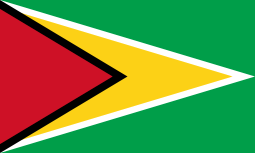







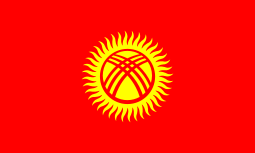


































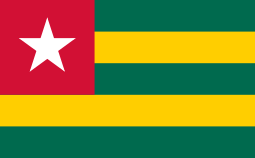









Former users

.svg.png)


.svg.png)
Illicit trade
Throughout the world, the AK and its variants are commonly used by governments, revolutionaries, terrorists, criminals, and civilians alike. In some countries, such as Somalia, Rwanda, Mozambique, Congo and Tanzania, the prices for Black Market AKs are between $30 and $125 per weapon and prices have fallen in the last few decades due to mass counterfeiting.[129] In Kenya, "an AK-47 fetches five head of cattle (about 10,000 Kenya shillings or 100 U.S. dollars) when offered for barter, but costs almost half that price when cash is paid".[130] There are places around the world where AK type weapons can be purchased on the black market "for as little as $6, or traded for a chicken or a sack of grain".[131][132][133]
The AK-47 has also spawned a cottage industry of sorts and has been copied and manufactured (one gun at a time) in small shops around the world (see Khyber Pass Copy).[134][135] The estimated numbers of AK-type weapons vary greatly. The Small Arms Survey suggest that "between 70 and 100 million of these weapons have been produced since 1947".[136] The World Bank estimates that out of the 500 million total firearms available worldwide, 100 million are of the Kalashnikov family, and 75 million are AK-47s.[4] Because AK-type weapons have been made in many countries, often illicitly, it is impossible to know how many really exist.[137]
Conflicts
.jpg)
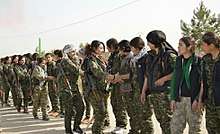
The AK-47 has been used in the following conflicts:
1960s
1970s
1980s
1990s
2010s
- Libyan Civil War (2011)
- Syrian Civil War (2011–present)
- Iraqi insurgency (2011–2013)
- Central African Republic Civil War (2012–present)[147]
Cultural influence and impact
— Larry Kahaner, author of AK-47: The Weapon That Changed the Face of War[148]
During the Cold War, the Soviet Union and the People's Republic of China, as well as United States and other NATO nations supplied arms and technical knowledge to numerous countries and rebel forces around the world. During this time the Western countries used relatively expensive automatic rifles, such as the FN FAL, the HK G3, the M14, and the M16. In contrast, the Russians and Chinese used the AK-47; its low production cost and ease of manufacture allow them to make AKs in vast numbers.
In the pro-communist states, the AK-47 became a symbol of the Third World revolution. They were utilized in the Cambodian Civil War and the Cambodian–Vietnamese War.[149] During the 1980s, the Soviet Union became the principal arms dealer to countries embargoed by Western nations, including Middle Eastern nations such as Iran, Libya, and Syria, which welcomed Soviet Union backing against Israel. After the fall of the Soviet Union, AK-47s were sold both openly and on the black market to any group with cash, including drug cartels and dictatorial states, and more recently they have been seen in the hands of Islamic groups such as Al-Qaeda, ISIL, and the Taliban in Afghanistan and Iraq, and FARC, Ejército de Liberación Nacional guerrillas in Colombia.[148]
.jpg)
In Russia, the Kalashnikov is a tremendous source of national pride.[150] "The family of the inventor of the world's most famous rifle, Mikhail Kalashnikov, has authorized German engineering company MMI to use the well-known Kalashnikov name on a variety of not-so-deadly goods."[151] In recent years, Kalashnikov Vodka has been marketed with souvenir bottles in the shape of the AK-47 Kalashnikov.[152][153] There are also Kalashnikov watches,[154] umbrellas,[155] and knives.[156][157]
The Kalashnikov Museum (also called the AK-47 museum) opened on 4 November 2004 in Izhevsk, Udmurt Republic. This city is in the Ural Region of Russia. The museum chronicles the biography of General Kalashnikov and documents the invention of the AK-47. The museum complex of Kalashnikov's small arms, a series of halls, and multimedia exhibitions are devoted to the evolution of the AK-47 rifle and attracts 10,000 monthly visitors.[158] Nadezhda Vechtomova, the museum director, stated in an interview that the purpose of the museum is to honor the ingenuity of the inventor and the hard work of the employees and to "separate the weapon as a weapon of murder from the people who are producing it and to tell its history in our country". Google Earth view of the Kalashnikov Museum
On 19 September 2017 a 9 metres (30 ft) monument of Kalashnikov was unveiled in central Moscow. A protester, later detained by police, attempted to unfurl a banner reading "a creator of weapons is a creator of death".[159]
The proliferation of this weapon is reflected by more than just numbers. The AK-47 is included on the flag of Mozambique and its emblem, an acknowledgment that the country gained its independence in large part through the effective use of their AK-47s.[160] It is also found in the coats of arms of East Timor and the revolution era Burkina Faso, as well as in the flags of Hezbollah, Syrian Resistance, FARC-EP, the New People's Army, TKP/TIKKO and the International Revolutionary People's Guerrilla Forces.
U.S. and Western Europe countries frequently associate the AK-47 with their enemies; both Cold War era and present-day. For example, Western works of fiction (movies, television, novels, video games) often portray criminals, gang members, insurgents, and terrorists using AK-47s as the weapon of choice. Conversely, throughout the developing world, the AK-47 can be positively attributed with revolutionaries against foreign occupation, imperialism, or colonialism. Numerous fictional depictions of the Soviet/Russian armed forces such as Call of Duty: Modern Warfare show them armed with 7.62×39mm AK variants (AK-47 or AKM) as their standard-issue rifles, a long-standing anachronism thanks to the AK-47's iconic status, despite the Soviets having actually replaced them with the 5.45×39mm AK-74 in the 1970s. Movies and video games often pass off licensed clones like the Norinco Type 56 rifle as the AK-47.[148]
In Ireland the AK-47 is associated with The Troubles due to its extensive use by republican paramilitaries during this period.[161] In 2013 a decommissioned AK-47 was included in the A History of Ireland in 100 Objects collection.[162]
The AK-47 made an appearance in U.S. popular culture as a recurring focus in the Nicolas Cage film Lord of War (2005). Numerous monologues in the movie focus on the weapon, and its effects on global conflict and the gun running market.[163]
In Iraq and Afghanistan, Private military company contractors from the U.K. and other countries used the AK-47 and its variants along with western firearms such as the AR-15.[164]
In 2006, the Colombian musician and peace activist César López devised the escopetarra, an AK converted into a guitar. One sold for US$17,000 in a fundraiser held to benefit the victims of anti-personnel mines, while another was exhibited at the United Nations' Conference on Disarmament.[165]
In Mexico, the AK-47 is known as "Cuerno de Chivo" (literally "Goat's Horn") because of its curved magazine design. It is one of the weapons of choice of Mexican drug cartels. It is sometimes mentioned in Mexican folk music lyrics.[166]
Gallery
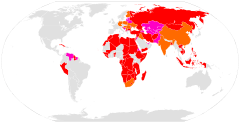 A map of current and former AK users
A map of current and former AK users An AK-47 Type 1 (top) and 2 (bottom) on display. The Type 1 features a stamped receiver while the Type 2 receiver is milled.
An AK-47 Type 1 (top) and 2 (bottom) on display. The Type 1 features a stamped receiver while the Type 2 receiver is milled.
 AK-47s of the PAIGC-liberation movement, ready to be transported from Senegal to Guinea-Bissau, 1973
AK-47s of the PAIGC-liberation movement, ready to be transported from Senegal to Guinea-Bissau, 1973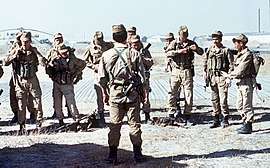
 During the Soviet–Afghan War in the 1980s, several sources simultaneously armed both sides of the Afghan conflict, filling the country with AK-47s and their derivatives.[167]
During the Soviet–Afghan War in the 1980s, several sources simultaneously armed both sides of the Afghan conflict, filling the country with AK-47s and their derivatives.[167]
See also
Notes
- Table data covers the AK-47 with Type 3 receiver
- 2.6 lb milled from 6 lb stock. This was about 2.2 lb heavier than the stamped receiver.
References
- Monetchikov 2005, chpts. 6 and 7: (if AK-46 and AK-47 are to be seen as separate designs).
- Ezell, Edward Clinton (1986). The AK47 Story, Evolution of the Kalashnikov Weapons. Stackpole Books. p. 112. ISBN 978-0-811709163.
- Poyer, Joe (2004). The AK-47 and AK-74 Kalashnikov Rifles and Their Variations. North Cape Publications inc. p. 8. ISBN 1-882391-33-0.
- Killicoat, Phillip (April 2007). "Weaponomics: The Global Market for Rifles" (PDF). World Bank Policy Research Working Paper 4202 (Post-Conflict Transitions Working Paper No. 10). Oxford University. p. 3. Archived (PDF) from the original on 12 January 2012. Retrieved 3 April 2010.
- "AK-47 Inventor Doesn't Lose Sleep Over Havoc Wrought With His Invention". USA: Fox News Channel. 6 July 2007. OCLC 36334372. Archived from the original on 3 June 2010. Retrieved 3 April 2010.
- НСД. 7,62-мм автомат АК 1967, pp. 161–162.
- НСД. 7,62-мм автомат АКМ (АКМС) 1983, pp. 149–150.
- "AKM (AK-47) Kalashnikov modernized rifle, caliber 7.62mm". Izhmash. Archived from the original on 6 October 2014.
- Monetchikov 2005, p. 67; Bolotin 1995, p. 129.
- Hallock, Richard R. (16 March 1970) M16 Rifle Case Study. Prepared for the Presidents Blue Ribbon Defense Panel Archived 6 September 2015 at the Wayback Machine. pogoarchives.org
- History of AK-47 Gun – The Gun Book Review Archived 3 August 2014 at the Wayback Machine. Popular Mechanics (12 October 2010).
- "Machine Carbine Promoted" Archived 21 September 2012 at the Wayback Machine. Tactical and Technical Trends, No. 57, April 1945.
- Rottman 2011, p. 9.
- The History of Kalashnikov Gun. Pravda. 02.08.2003 Archived 15 October 2015 at the Wayback Machine. English.pravda.ru. Retrieved 25 November 2015.
- "Mikhail Kalashnikov: The Father of 100 Million Rifles". Field & Stream. February 2006. Archived from the original on 15 August 2016. Retrieved 19 April 2015.
- Johnson, Harold E. (September 1973) Small Arms Identifiction and Operations Guide-Eurasain Communist Countries Archived 4 March 2016 at the Wayback Machine. U.S. Army Foreign Science and Technology Center of the U.S. Army Materiel Command.
- Walsh, Nick Paton (10 October 2003). "Mikhail Kalashnikov: 'I sleep soundly'". The Guardian. Archived from the original on 10 May 2017. Retrieved 12 January 2016.
- Russia celebrates Mikhail Kalashnikov's 90th birthday – the designer who armed the world Archived 9 December 2015 at the Wayback Machine. 39;Rossiyskaya Gazeta via Telegraph.co.uk (28 October 2009). Retrieved 25 November 2015.
- Bolotin 1995, pp. 123–124.
- An interview with Mikhail Kalashnikov, Robert Fisk, The Independent (centrist), London, England. 22 April 2001. http://www.worldpress.org/cover5.htm Archived 1 October 2016 at the Wayback Machine
- AK-47 Inventor Doesn't Lose Sleep Over Havoc Wrought With His Invention. An interview with Mikhail Kalashnikov Archived 14 January 2014 at the Wayback Machine. Associated Press via Fox News Channel (6 July 2007). Retrieved 25 November 2015.
- Popenker, Maksim (5 February 2009). "Kalashnikov AK (AK-47) AKS, AKM and AKMS rifles (USSR)". World Guns. Modern Firearms & Ammunition. Archived from the original on 11 March 2011. Retrieved 14 March 2011.
- Kuptsov, Andrei (2001). Странная история оружия: С. Г. Симонов, неизвестный гений России, или кто и как разоружил русского солдата [Odd History of Weapons: S. G. Simonov, an Unknown Genius of Russia, or How and Who Disarmed the Russian Soldier] (in Russian). Moscow: Kraft+. p. 262. ISBN 978-5-93675-025-0.
- Bolotin 1995, p. 123.
- Monetchikov 2005, p. 38.
- Bolotin, David Naumovich [translation: Igor F. Naftul'eff ; edited by John Walter, Heikki Pohjolainen] (1995). Soviet Small-arms and Ammunition. Hyvinkää: Finnish Arms Museum Foundation (Suomen asemuseosäätiö). p. 150. ISBN 9519718419.CS1 maint: uses authors parameter (link)
- Shilin, Val; Cutshaw, Charlie. "Mikhail Kalashnikov". Power Custom. Archived from the original on 2 April 2005. Retrieved 19 October 2008.
- Patrick Sweeney (2010) The Gun Digest Book of The AR-15, Vol. 3. Gun Digest Books. p. 20. ISBN 1440213763.
- Bolotin, David Naumovich [translation: Igor F. Naftul'eff ; edited by John Walter, Heikki Pohjolainen] (1995). Soviet Small-arms and Ammunition. Hyvinkää: Finnish Arms Museum Foundation (Suomen asemuseosäätiö). p. 115. ISBN 9519718419.CS1 maint: uses authors parameter (link)
- Monetchikov 2005, p. 36.
- Kalashnikov AK (AK-47) AKS, AKM and AKMS rifles (USSR) Archived 20 January 2013 at the Wayback Machine. World.guns.ru. Retrieved 25 November 2015.
- Popenker, Maxim; Williams, Anthony G (2005). Assault Rifle. Crowood Press. ISBN 978-1-86126-700-9.
- https://www.forgottenweapons.com/ak-and-stg-kissing-cousins/AK and StG – Kissing Cousins, 12 December 2012, by Ian McCollum
- Monetchikov 2005, p. 64.
- Poyer 2006, pp. 8–11.
- Ezell, Edward (1986). The AK47 story: evolution of the Kalashnikov weapons. Stackpole Books. p. 36. ISBN 978-0-8117-0916-3.
- "ForgottenWeapons.com: Russian AK-49". Archived from the original on 8 July 2018. Retrieved 8 July 2018.
- "Type 2 & Type 3 AK-47". browningmgs.com. Archived from the original on 26 October 2016. Retrieved 19 June 2015.
- Poyer 2006, p. 2.
- "An AK for Every Market by James Dunnigan April 23, 2003". strategypage.com. Archived from the original on 25 March 2007. Retrieved 26 June 2009.
- The Battle Rifle: Development and Use Since World War II, By Russell C. Tilstra, (McFarland 2014) page 25-28
- Dockery, Kevin (2007). Future Weapons. p. 102. ISBN 978-0-425-21750-4.
- Land Forces Weapons: Export Catalogue. Moscow: Rosoboronexport. 2003. p. 85. OCLC 61406322. Archived from the original on 14 June 2017. Retrieved 8 September 2017.
- Bellamy RF and Zajtchuk R. (1990) "The physics and biophysics of wound ballistics". In: Zajtchuk R, ed. Textbook of Military Medicine, Part I: Warfare, Weaponry, and the Casualty, Vol. 5, Conventional Warfare: Ballistic, Blast, and Burn Injuries. Washington, DC: Office of the Surgeon General, Department of the Army, United States of America. pp. 146–155
- "Patterns of Military Rifle Bullets". Ciar.org. Archived from the original on 20 November 2012. Retrieved 23 August 2012.
- Roberts, G.K. (21 May 2008) U.S. Military Small Arms Ammunition Failures and Solutions Archived 28 June 2011 at the Wayback Machine, NDIA Dallas, TX.
- Fackler, ML; Malinowski, JA; Hoxie, SW; Jason, A. (September 1990). "Wounding effects of the AK-47 rifle used by Patrick Purdy in the Stockton, California, schoolyard shooting of January 17, 1989". American Journal of Forensic Medicine and Pathology. 11 (3): 185–9. doi:10.1097/00000433-199009000-00001. PMID 2220700.
- Bellamy RF and Zajtchuk R. (1990) "The physics and biophysics of wound ballistics. In: Zajtchuk R, ed. Textbook of Military Medicine, Part I: Warfare, Weaponry, and the Casualty, Vol. 5, Conventional Warfare: Ballistic, Blast, and Burn Injuries. Washington, DC: Office of the Surgeon General, Department of the Army, United States of America (1990) Fig. 4-38 p. 148
- "Military rifle bullet wound patterns". Archived from the original on 10 September 2011. Retrieved 2 October 2014.
- Fackler, Martin L. "Military rifle bullet wound patterns comparison charts". Frfrogspad.com. Archived from the original on 16 August 2014. Retrieved 29 June 2014.
- Department of the Army. 203d Military Intelligence Battalion
- Peter G. Kokalis, Kalashnikovs – 3 of the best. arsenalinc.com Archived 23 September 2015 at the Wayback Machine. (PDF). Retrieved 25 November 2015.
- "Ak 47 Technical Manual". Archived from the original on 8 October 2014. Retrieved 2 October 2014.
- Rottman 2011, p. 42.
- "Identifying & Collecting the 7.62×39 AK-47/AKM Magazine". Small Arms Defense Journal. Archived from the original on 6 October 2014. Retrieved 2 October 2014.
- The many uses of an AK-47 magazine video Archived 17 May 2015 at the Wayback Machine. YouTube.com (7 May 2014). Retrieved 25 November 2015.
- "Ak 47 Technical Description – Manual". Scribd.com. 30 September 2010. Archived from the original on 28 March 2012. Retrieved 23 August 2012.
- "Kalashnikovs 3 of the best" (PDF). Shotgun News. 59 (12). May 2005. Archived (PDF) from the original on 23 September 2015. Retrieved 15 June 2012.
- Grezin V. M. (1966). "Elastic characteristics of AG-4S glass-reinforced plastic under short-time and long-time loads". Polymer Mechanics. 2 (2): 188–190. Bibcode:1966PoMec...2..188G. doi:10.1007/BF00867112.
- Kokalis, 49
- Rifle Evaluation Study, United States Army, Combat Development Command, ADA046961, 20 Dec 1962 Archived 1 December 2012 at the Wayback Machine. None. Retrieved 25 November 2015.
- "Are kalashnikov magazines as robust as their reputation? He tormented a selection of AR magazines last year, now he takes on the AK. The results you may find surprising". Archived from the original on 6 October 2014. Retrieved 2 October 2014.
- Cobb, Ralph E. (2010). "AK Bayonets 101 – The Four Basic Types". Worldbayonets.com. Archived from the original on 24 March 2015. Retrieved 25 November 2015.
- "40 mm underbarrel grenade launcher GP-34". Izhmash. Archived from the original on 28 July 2012. Retrieved 20 October 2012.
- Russian Close Combat Weapon. Moscow: Association "Defense Enterprises Assistance League". 2010. pp. 482–489. ISBN 978-5-904540-04-3.
- Operator's Manual for AK-47 Rifle. Department of the Army Archived 22 January 2014 at the Wayback Machine. (PDF). Retrieved 25 November 2015.
- "7.62 mm Kalashnikov assault rifles AK103, АК104". Izhmash. Archived from the original on 21 April 2012. Retrieved 8 June 2012.
- Rottman 2011, p. 39.
- Norinco. "Instruction Manual Model MAK-90 Semi-Automatic Rifle" (PDF). mouseguns.com. Archived (PDF) from the original on 4 March 2016. Retrieved 12 January 2016.
- "wz.88 Tantal". Forgotten Weapons. Archived from the original on 6 October 2014. Retrieved 2 October 2014.
- "Arsenal 7.62mm "Arsenal" Rifle AR-M1 and with Folding Butt AR-M1F". Archived from the original on 6 October 2014. Retrieved 2 October 2014.
- Hanson, Victor Davis (2011). "The Most Popular Gun in the World". The New Atlantis. 32: 140–147. Archived from the original on 12 September 2014. Retrieved 1 July 2014.
- Greenewald, John. "Soviet Weapon-System Acquisition". Archived from the original on 7 March 2016. Retrieved 8 September 2017.
- Monetchikov 2005, p. 76.
- "AKML (AKMSL)". AK-INFO.RU. Archived from the original on 23 May 2013. Retrieved 8 February 2013.
- Albanian Small Arms Archived 14 October 2017 at the Wayback Machine by Aftermath Gun Club.
- Азербайджан приступил к серийному производству автоматов АК-74М по российской лицензии [Azerbaijan began serial production of AK-74M rifles under Russian license]. ЦАМТО (in Russian). Moscow: Centre for Analysis of World Arms Trade. 8 July 2011. Archived from the original on 22 September 2013. Retrieved 8 July 2011.
- Dimov, Roman. "Kalashnikov Arms Versions". The AK Site. Archived from the original on 29 September 2007.
- "MPi-K / MPi-AK Assault Rifle Series". Энциклопедия оружия и боеприпасов (in Russian). Archived from the original on 29 June 2013. Retrieved 19 February 2013.
- "Advertisement flyer for manufacturing capabilities of the Gafat Armament Engineering Complex". Archived from the original on 10 July 2011. Retrieved 23 January 2014.CS1 maint: BOT: original-url status unknown (link) Retrieved on 8 October 2010.
- "Венгрия – Штурмовые винтовки / Автоматы – Оружие – Энциклопедия оружия и боеприпасов (огнестрельное ручное оружие, боеприпасы и снаряжение) – Страница 1". Archived from the original on 6 October 2014. Retrieved 2 October 2014.
- Unnithan, Sandeep (30 December 2013) "Why General Kalashnikov couldn't sell the AK in India" Archived 16 April 2015 at the Wayback Machine. India Today.
- "Assault Rifle 7,62mm" Archived 27 October 2010 at the Wayback Machine. Indian Ordnance Factory Board
- "Bernardelli company profile and history". V. Bernardelli S.r.l. Archived from the original on 10 February 2013. Retrieved 20 February 2013.
- "DEFENCE INDUSTRY CORPORATION OF NIGERIA (DICON) OFFICIAL WEBSITE". Archived from the original on 27 December 2013. Retrieved 2 October 2014.
- "People's Daily Online – Nigeria to mass-produce Nigerian version of AK-47 rifles". Archived from the original on 19 October 2013. Retrieved 2 October 2014.
- US Department of Defense, North Korea Country Handbook 1997, Appendix A: Equipment Recognition, PPSH 1943 SUBMACHINEGUN (TYPE-50 CHINA/MODEL-49 DPRK), p. A-79.
- US Department of Defense, North Korea Country Handbook 1997, Appendix A: Equipment Recognition, TYPE-68 (AKM) RIFLE, p. A-77.
- Chang, Andrei (16 November 2009). "Russia confronts Pakistan, China over copied weapons". upiasia.com. Archived from the original on 17 July 2011.
- "Poland. Assault Rifles". Энциклопедия оружия и боеприпасов (in Russian). Archived from the original on 19 March 2013. Retrieved 19 February 2013.
- "MAZ". Military Industry Corporation. Archived from the original on 27 December 2008. Retrieved 8 February 2009.
- Raigorodetsky, Aleksandr (6 October 2011). Автомат "Малюк" ("Малыш") (Украина) ["Malyuk" Assault Rifle (Ukraine)]. Оружейная экзотика (in Russian). Archived from the original on 3 September 2015.
- Sieff, Martin (15 August 2007). "Defense Focus: Venezuela's Kalashnikovs". United Press International. Archived from the original on 4 June 2008. Retrieved 19 October 2008.
- "Восточная Европа захватила рынок продаж автоматов Калашникова". Lenta.ru. 13 June 2006. Archived from the original on 2 July 2006.
- "'Ижмаш' подсчитал контрафактные автоматы Калашникова". Lenta.ru. 15 April 2006. Archived from the original on 23 June 2006. Retrieved 13 June 2006.
- "The USA's M4 Carbine Controversy". Defenseindustrydaily.com. 21 November 2011. Archived from the original on 13 July 2007. Retrieved 10 January 2012.
- "Avtomat Kalashnikov". alpharubicon.com. Archived from the original on 13 May 2012. Retrieved 10 June 2012.
- C. J. Chivers (2011) The Gun. Simon & Schuster Publishing. ISBN 0743271734. pp. 206–207. Taken from the Long-Range Dispersion Firing Test of the AK-47 Rifle, U.S. Army Foreign Science and Technology Center. August 1969
- Kjellgren, G. L. M. The Practical Range of Small Arms Archived 5 March 2015 at the Wayback Machine. The American Rifleman. pp. 40–44.
- НСД. 7,62-мм автомат АКМ (АКМС) 1983, p. 155: (under the default conditions of no wind and sea level atmospheric pressure, 15 °C (59 °F)).
- "TECHNICAL REPORT NO. 461 SYSTEM ERROR BUDGETS, TARGET DISTRIBUTIONS AND HITTING PERFORMANCE ESTIMATES FOR GENERAL-PURPOSE RIFLES AND SNIPER RIFLES OF 7.62 X 51 MM AND LARGER CALIBERS JONATHAN M. WEAVER, JR. LTC, INFANTRY, U.S. ARMY (RETIRED) MAY 1990 U.S. ARMY MATERIEL SYSTEMS ANALYSIS ACTIVITY ABERDEEN PROVING GROUND, MARYLAND, Page 87" (PDF). Archived (PDF) from the original on 23 November 2015. Retrieved 28 March 2019.
- Instruction on small business 7,62- mm Kalashnikov (AK). - Moscow: Military Publishing House of the Ministry of Defense of the USSR, 1967.
- Kahaner, Larry (26 November 2006). "Weapon of Mass Destruction". The Washington Post. Archived from the original on 27 September 2011. Retrieved 3 April 2010.
- Richard D. Jones; Leland S. Ness, eds. (27 January 2009). Jane's Infantry Weapons 2009–2010 (35 ed.). Jane's Information Group. ISBN 978-0-7106-2869-5.
- "Burkina Faso Army defence force ranks military pattern camouflage combat field uniforms dress grades – Army Recognition – Army Recognition". Armyrecognition.com. Archived from the original on 19 October 2013. Retrieved 29 December 2013.
- "Burkina : nouveau mouvement de colère des militaires à Ouagadougou". Africa Defense Journal. 24 May 2011. Archived from the original on 23 October 2013. Retrieved 29 December 2013.
- "Burkina Faso: Ces Mesures Présidentielles Qui Font Plaisir à l'Armée". afrikitalia.it. Archived from the original on 17 October 2013. Retrieved 29 December 2013.
- "Blending". Flickr. 21 July 2012. Archived from the original on 22 October 2013. Retrieved 29 December 2013.
- "Latest edition of the SSR Monitor: Burundi focuses on armed forces reform". Security Sector Reform Resource Centre. 20 December 2013. Archived from the original on 18 October 2013. Retrieved 29 December 2013.
- Gander, Terry J.; Hogg, Ian V. (1 May 1995). Jane's Infantry Weapons 1995–96 (21 ed.). Jane's Information Group. ISBN 978-0-7106-1241-0. Archived from the original on 18 March 2015. Retrieved 6 March 2016.
- Miller, David M. O. (1 May 2001). The Illustrated Directory of 20th Century Guns. Illustrated Directory Series. Salamander Books. ISBN 978-1-84065-245-1. Archived from the original on 19 March 2015. Retrieved 6 March 2016.
- roberthuffstutter (22 December 2011). "Djiboutian Army Quick Reaction Regiment trains at Ali Oune, Djibouti, February 2011 | Flickr – Photo Sharing!". Flickr. Archived from the original on 22 October 2013. Retrieved 29 December 2013.
- "Djibouti Army ranks land ground forces combat field uniforms military grades uniformes de – Army Recognition – Army Recognition". Armyrecognition.com. Archived from the original on 19 October 2013. Retrieved 29 December 2013.
- Milosevic, Milan (2005). "Trojanski Konj za Teroriste". Kalibar (in Serbian). Novosti. Archived from the original on 27 February 2012. Retrieved 4 April 2009.
- "Greece Ministry of Public Order Press Office: Special Anti-Terrorist Unit" (PDF). Hellenic Police. July 2004. Archived from the original (PDF) on 21 July 2010. Retrieved 27 September 2009.
- "Maha's elite counter terror unit Force One becomes operational". Business Standard. New Delhi: Business Standard Ltd. 25 November 2009. OCLC 496280002. Retrieved 5 July 2010.
- https://www.shadowspear.com/2009/01/kopassus/
- Jurado, Carlos Caballero (1990). Central American Wars 1959-89. Men-at-Arms 221. London: Osprey Publishing. pp. 20, 45. ISBN 9780850459456.CS1 maint: ref=harv (link)
- Nikolovski, Zoran (12 October 2006). "Macedonian military police, US National Guard conduct joint manoeuvres". Southeast European Times. United States European Command. OCLC 731936128. Archived from the original on 25 January 2011. Retrieved 14 March 2011.
- http://www.aljazeera.com/amp/indepth/features/darra-adam-khel-pakistan-dying-gun-bazaar-190204090518478.html
- Modern Firearms – AK-47 AKM Archived 6 March 2008 at the Wayback Machine. World.guns.ru (24 January 2011). Retrieved on 14 March 2011.
- "Rwanda Rwandan Army ranks land ground forces combat uniforms military equipment rwandais grades unif – Army Recognition – Army Recognition". Armyrecognition.com. Archived from the original on 23 September 2015. Retrieved 29 December 2013.
- "UAE, Saudi Arabia Dispatch Troops to Syria". 22 November 2018. Archived from the original on 22 November 2018. Retrieved 28 March 2019.
- https://www.marketwatch.com/story/the-russian-guns-are-coming-ak-47s-could-soon-be-american-made-2015-01-22
- https://www.thefirearmblog.com/blog/2016/04/12/aks-among-u-s-police-departments/
- https://nationalinterest.org/blog/buzz/why-us-commandos-loved-ak-47-rifle-44872
- Wells, Rod. Part-Time War (2011 ed.). Fern House. p. 155. ISBN 978-1-902702-25-4.
- D. M. O. Miller (31 August 2001). Illustrated directory of twentieth century guns. ISBN 978-1-84065-245-1.
- The AK-47: The World's Favourite Killing Machine. ControlArms Briefing Note (26 June 2006)
- Illicit Flows and Criminal Things: States, Borders, and the Other Side of Globalization. By Willem van Schendel, Itty Abraham. Indiana University Press, 4 November 2005 – Political Science – page 217
- Small arms in Africa: Counting the cost of gun violence. Un.org (6 July 2000).
- United Nations High Commissioner for Refugees. "Refworld – Playing with Fire: Weapons Proliferation, Political Violence, and Human Rights in Kenya". Refworld. Archived from the original on 20 November 2012.
- AFTE Journal – Volume 45 Number 3 – Summer 2013 Archived 4 March 2016 at the Wayback Machine. (PDF). Retrieved 25 November 2015.
- Santos, Soliman M. Jr. (April 2010) Primed and purposeful armed groups and human security efforts in the Philippines. South–South Network for Non-State Armed Group Engagement and the Small Arms Survey Archived 24 September 2015 at the Wayback Machine. Philippines/Switzerland. ISBN 978-2-940415-29-8.
- "Craft Production of Small Arms" Archived 24 September 2015 at the Wayback Machine. Small Arms Survey Research Notes • Number 3 • March 2011 pp. 1–2.
- "Continuity and Change: PRODUCTS AND PRODUCERS" Archived 14 May 2012 at the Wayback Machine. Small Arms Survey 2004.
- Graves-Brown, P. (November 2007). "Avtomat Kalashnikova". Journal of Material Culture. 12 (3): 285–307. doi:10.1177/1359183507081896.
- http://www.nybooks.com/articles/2011/02/10/most-influential-weapon-our-time/ Archived 11 August 2017 at the Wayback Machine The Most Influential Weapon of Our Time. The New York Review of Books. Max Hastings 10 FEBRUARY 2011 ISSUE. "József Tibor Fejes, a young Hungarian identified by C. J. Chivers in The Gun as 'the first known insurgent to carry an AK-47.' According to Chivers, 'Fejes obtained his prize after Soviet soldiers dropped their rifles during their attack on revolutionaries in Budapest in 1956…. The Hungarian Revolution marked the AK-47's true battlefield debut."
- https://www.alamy.com/stock-photo-geographytravel-congo-events-simba-uprising-1964-1965-mercenary-with-58514865.html
- Abbott, Peter; Botham, Philip (15 June 1986). Modern African Wars (1): Rhodesia 1965–80. Men-at-Arms 183. Osprey Publishing. p. 10. ISBN 9780850457285.
- Scarlata, Paul (1 March 2009). "Ethiopian military rifle cartridges: Part 2: from Mauser to Kalashnikov". Shotgun News. Archived from the original on 24 November 2018. Retrieved 24 November 2018.
- https://nara.getarchive.net/media/soviet-made-ak-47-assault-rifles-seized-during-operation-urgent-fury-on-the-a52b7b
- Small Arms Survey (2007). "Persistent Instability: Armed Violence and Insecurity in South Sudan" (PDF). The Small Arms Survey 2007: Guns and the City. Cambridge University Press. p. 325. ISBN 978-0-521-88039-8. Archived from the original on 27 August 2018. Retrieved 29 August 2018.
- Small Arms Survey (2005). "Sourcing the Tools of War: Small Arms Supplies to Conflict Zones" (PDF). Small Arms Survey 2005: Weapons at War. Oxford University Press. p. 166. ISBN 978-0-19-928085-8. Archived from the original on 30 August 2018. Retrieved 29 August 2018.
- Small Arms Survey (2007). "Armed Violence in Burundi: Conflict and Post-Conflict Bujumbura" (PDF). The Small Arms Survey 2007: Guns and the City. Cambridge University Press. p. 204. ISBN 978-0-521-88039-8. Archived from the original on 27 August 2018. Retrieved 29 August 2018.
- Small Arms Survey (2003). "Making the Difference?: Weapon Collection and Small Arms Availability in the Republic of Congo" (PDF). Small Arms Survey 2003: Development Denied. Oxford University Press. p. 268. ISBN 0199251754. Archived from the original on 29 August 2018. Retrieved 29 August 2018.
- Touchard, Laurent (17 December 2013). "Centrafrique : le Soudan a-t-il armé les ex-Séléka ?". Jeune Afrique (in French). Archived from the original on 30 January 2019. Retrieved 29 January 2019.
- Seabrook, Andrea (26 November 2006) "AK-47: The Weapon Changed the Face of War". NPR Weekend Edition Sunday.
- Christopher Jones (20 December 1981), "IN THE LAND OF THE KHMER ROUGE." Archived 11 December 2017 at the Wayback Machine The New York Times.
- "AK-47 rifle inventor Mikhail Kalashnikov dies at 94". Reuters UK. 24 December 2013. Archived from the original on 14 June 2015. Retrieved 13 June 2015.
- "Care for a Kalashnikov Umbrella?, THE MOSCOW TIMES". Archived from the original on 10 June 2014.
- The AK 47 Kalashnikov Vodka Souvenir Bottle Archived 27 February 2015 at the Wayback Machine. Russianvodka.com.au. Retrieved 25 November 2015.
- "Celebrate 2010 with a Kalashnikov!". WIRED. 31 December 2009. Archived from the original on 5 July 2017. Retrieved 4 March 2017.
- "Kalashnikov watchesswiss made – Kalashnikov uhren". Kalashnikov watches- swiss made – Kalashnikov uhren. Archived from the original on 15 June 2015. Retrieved 13 June 2015.
- "Europe – Coming soon – the Kalashnikov brolly?". BBC. Archived from the original on 14 June 2015. Retrieved 13 June 2015.
- "EDC for CCW: Boker Kalashnikov Anniversary Knife". The Truth About Knives. June 2013. Archived from the original on 15 June 2015. Retrieved 13 June 2015.
- "Boker Kalashnikov Knives". bladehq.com. Archived from the original on 15 June 2015. Retrieved 13 June 2015.
- Chivers, C.J. (18 February 2007) "AK-47 Museum: Homage to the Gun That Won the East" Archived 22 June 2007 at the Wayback Machine. The New York Times
- Bennetts, Marc (19 September 2017). "30ft-high statue of Mikhail Kalashnikov unveiled in Moscow". Archived from the original on 19 September 2017. Retrieved 19 September 2017 – via www.theguardian.com.
- Gordon, Michael R. (13 March 1997) "Burst of Pride for a Staccato Executioner: AK-47" Archived 23 June 2017 at the Wayback Machine. The New York Times.
- Oppenheimer, A. R. (2009). IRA: The Bombs and The Bullets. A History of Deadly Ingenuity. Irish Academic Press, chapter 4. ISBN 978-0-7165-2895-1
- O'Toole, Fintan. "A History of Ireland in 100 Objects: Decommissioned AK-47 assault rifle, 2005". The Irish Times. Retrieved 12 May 2020.
- "Lord of War (2005) – memorable quotes". Internet Movie Database. Retrieved 29 October 2012.
- G4S Iraq
- Héctor Latorre (24 January 2006). "Escopetarras: disparando música". BBC World. Archived from the original on 22 February 2007. Retrieved 31 January 2007.
- Muessig, Ben (10 August 2010). "Narcocorridos: The Songs of Mexico's Drug War". AolNews. Archived from the original on 14 August 2012.
- "How did the AK-47 become the most abundant weapon on earth?". The Independent. 24 December 2013. Archived from the original on 25 September 2015. Retrieved 21 August 2017.
Bibliography
- Bolotin, David Naumovich (1995). История советского стрелкового оружия и патронов [The History of Soviet Small-arms and Ammunition] (PDF). Voyenno-Istoricheskaya Biblioteka (in Russian). Saint Petersburg: Poligon. ISBN 5-85503-072-5.CS1 maint: ref=harv (link)
- Monetchikov, Sergei Borisovich (2005). История русского автомата [The History of Russian Assault Rifle]. Entsiklopediya Russkoi Armii (in Russian). Izdatel'stvo "Atlant 44". ISBN 5-98655-006-4. Archived from the original on 16 May 2013.CS1 maint: ref=harv (link)
- Poyer, Joe (1 January 2006). The AK-47 and AK-74 Kalashnikov Rifles and Their Variations: A Shooter's and Collector's Guide. North Cape Publications. ISBN 978-1-882391-41-7.CS1 maint: ref=harv (link)
- Rottman, Gordon (24 May 2011). The AK-47: Kalashnikov-series assault rifles. Osprey Publishing. ISBN 978-1-84908-835-0.CS1 maint: ref=harv (link)
Further reading
- Chivers, C.J (October 2010). The Gun. Simon & Schuster. p. 459. ISBN 978-0-7432-7076-2.
- Ezell, Edward Clinton; R. Blake Stevens (1 December 2001). Kalashnikov: The Arms and the Man. Cobourg, ON: Collector Grade Publications. ISBN 978-0-88935-267-4.
- Gulevich, I. D., ed. (1967). НСД. 7,62-мм автомат АК [7.62 mm AK] (in Russian) (3 ed.). Moscow: Voenizdat.
- Michael Hodges (January 2007). Ak47: The Story of the People's Gun. Hodder & Stoughton. ISBN 978-0-340-92104-3.
- Honeycutt Jr, Fred L. and Anthony, Patt F. Military Rifles of Japan. (1996) Fifth Edition, 8th printing; Julin Books. ISBN 0-9623208-7-0.
- Kahaner, Larry (2007). AK-47: the weapon that changed the face of war. John Wiley & Sons. ISBN 978-0-471-72641-8.CS1 maint: ref=harv (link)
- Kalashnikov, Mikhail Timofeevich; Joly, Elena (2006). The gun that changed the world. Polity Press. ISBN 978-0-7456-3691-7.
- Shilin, Valery; Cutshaw, Charlie (1 March 2000). Legends and Reality of the AK: A Behind-The Scenes Look at the History, Design, and Impact of the Kalashnikov Family of Weapons. Paladin Press. ISBN 978-1-58160-069-8.
- Vilchinsky, I. K., ed. (1983). НСД. 7,62-мм автомат АКМ (АКМС) [7.62 mm AKM (AKMS)] (in Russian) (3 ed.). Moscow: Voenizdat.
- John Walter (4 September 1999). Kalashnikov: machine pistols, assault rifles, and machine-guns, 1945 to the present. Greenhill Books/Lionel Leventhal. ISBN 978-1-85367-364-1.
- How the AK-47 Rewrote the Rules of Modern Warfare – Three-part article by C. J. Chivers, for Wired Magazine
- Ружье. Оружие и амуниция 1999/3, pp. 18–21 has an article about the AK-47 prototypes
- М.Т. Kalashnikov, "Кто автор АК-47?" (Who is the author of AK-47?) – an article rejecting some of the alternative theories as to the authorship of the AK-47, Kalashnikov magazine, 2002/2, pp. 4–7 (in Russian)
- М. Degtyaryov, "Неочевидное очевидное" – an article comparing the internals of the StG 44 and AK-47, Kalashnikov magazine, 2009/4, pp. 18–23 (in Russian)
- "В преддверии юбилея..." Transcription of the commission report on the testing round from the summer of 1947; no winner was selected at this point, but the commission held Kalashnikov's, Dementiev's and Bulkin's designs as most closely satisfying TTT number 3131. Kalashnikov magazine, 2009/8, pp. 18–22 (in Russian)
- "Путёвка в жизнь" Report/letter on the final round of testing, 27 December 1947, declaring Kalashnikov's design the winner. Kalashnikov magazine, 2009/9, pp. 16–22 (in Russian)
- Articles on the 1948 military trials: "На пути в войска" and "ПЕРВЫЙ В ДИНАСТИИ", Kalashnikov magazine, 2009/10-11
- Fackler; Surinchak, John S.; Malinowski, John A.; Bowen, Robert E. (1984). "Wounding potential of the Russian AK-74 assault rifle". Journal of Trauma-Injury Infection & Critical Care. 24 (3): 263–6. doi:10.1097/00005373-198403000-00014. PMID 6708147.
External links
- US Army Operator's Manual for the AK-47 Assault Rifle
- AK Site – Kalashnikov Home Page (Mirror) at the Wayback Machine (archived 29 September 2007)
- Nazarian's Gun's Recognition Guide (MANUAL) AK 47 Manual (.pdf)
- The Timeless, Ubiquitous AK-47 – slideshow by Time magazine
- Legendary Kalashnikov: Story of AK-47 Rifle (RT's Documentary)
- AK-47: The Weapon Changed the Face of War – audio report by NPR
- The AK-47: The Gun That Changed The Battlefield – audio report by NPR
- AK-47 Documentary: Part 1 & Part 2 by Al Jazeera English
- AK-47 Full Auto, U.S. Army in Iraq from the Internet Archive
- Years of the gun: A political history of the AK-47 in Pakistan by Dawn News
- Piston Red Dot Sights by Internet Archive
